Abstract
Alveolar hypoxia causes pulmonary vasoconstriction; we investigated whether hypoxia could also impair pulmonary vasodilation. We found in the isolated perfused rat lung a delay in vasodilation following agonist-induced vasoconstriction. The delay was not due to erythrocyte or plasma factors, or to alterations in base-line lung perfusion pressure. Pretreating lungs with arachidonic acid abolished hypoxic vasoconstriction, but did not influence the hypoxia-induced impairment of vasodilation after angiotensin II, bradykinin, or serotonin pressor responses. Progressive slowing of vasodilation followed angiotensin II-induced constriction as the lung oxygen tension fell progressively below 60 Torr. KCl, which is not metabolized by the lung, caused vasoconstriction; the subsequent vasodilation time was delayed during hypoxia. However, catecholamine depletion in the lungs abolished this hypoxic vasodilation delay after KCl-induced vasoconstriction. In lungs from high altitude rats, the hypoxia-induced vasodilation impairment after an angiotensin II pressor response was markedly less than it was in lungs from low altitude rats. We conclude from these studies that (a) hypoxia impairs vasodilation of rat lung vessels following constriction induced by angiotensin II, serotonin, bradykinin, or KCl, (b) hypoxia slows vasodilation following KCl-induced vasoconstriction probably by altering lung handling of norepinephrine, (c) the effect of hypoxia on vasodilation is not dependent on its constricting effect on lung vessels, (d) high altitude acclimation moderates the effect of acute hypoxia on vasodilation, and (e) the hypoxic impairment of vasodilation is possibly the result of an altered rate of dissociation of agonists from their membrane receptors on the vascular smooth muscle.
Full text
PDF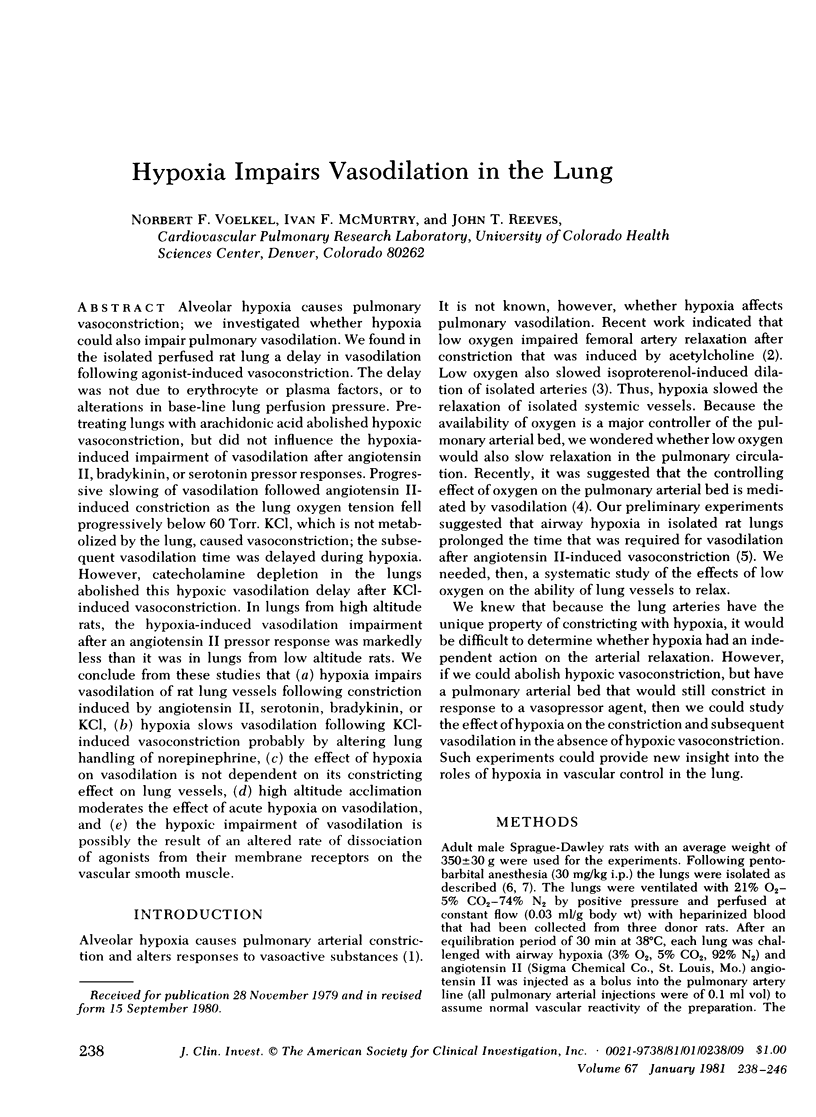
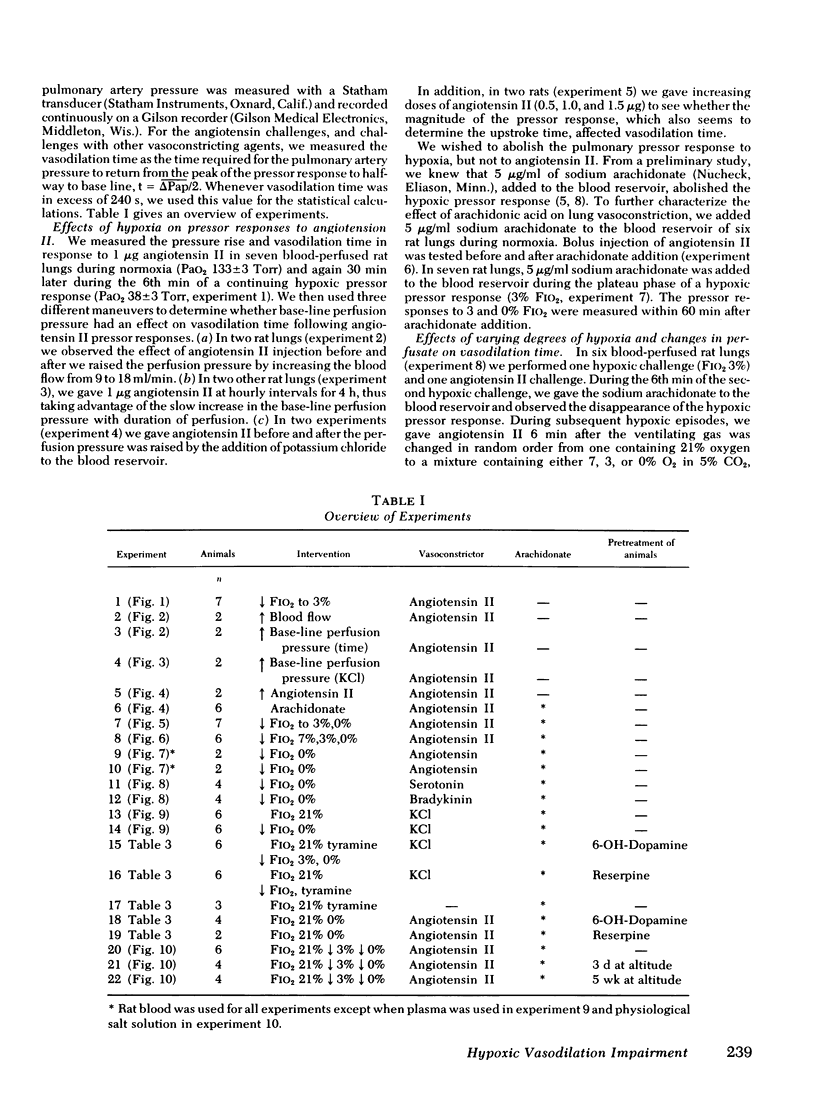
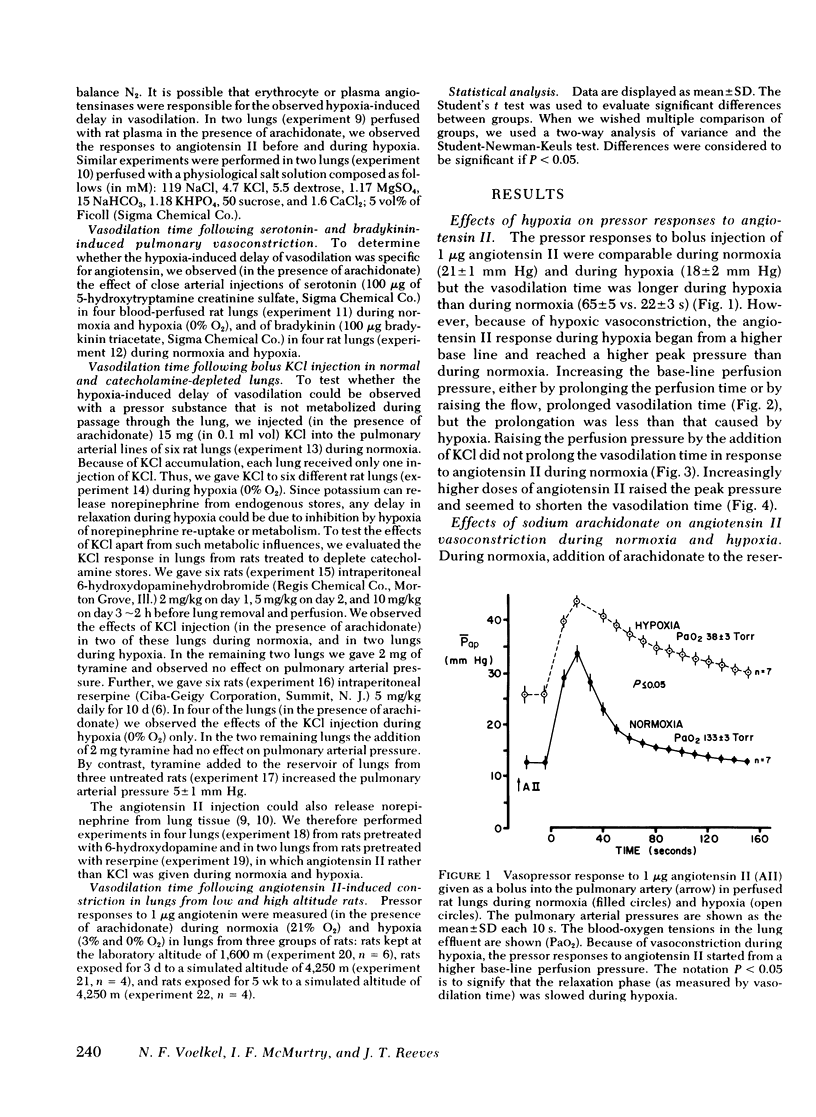
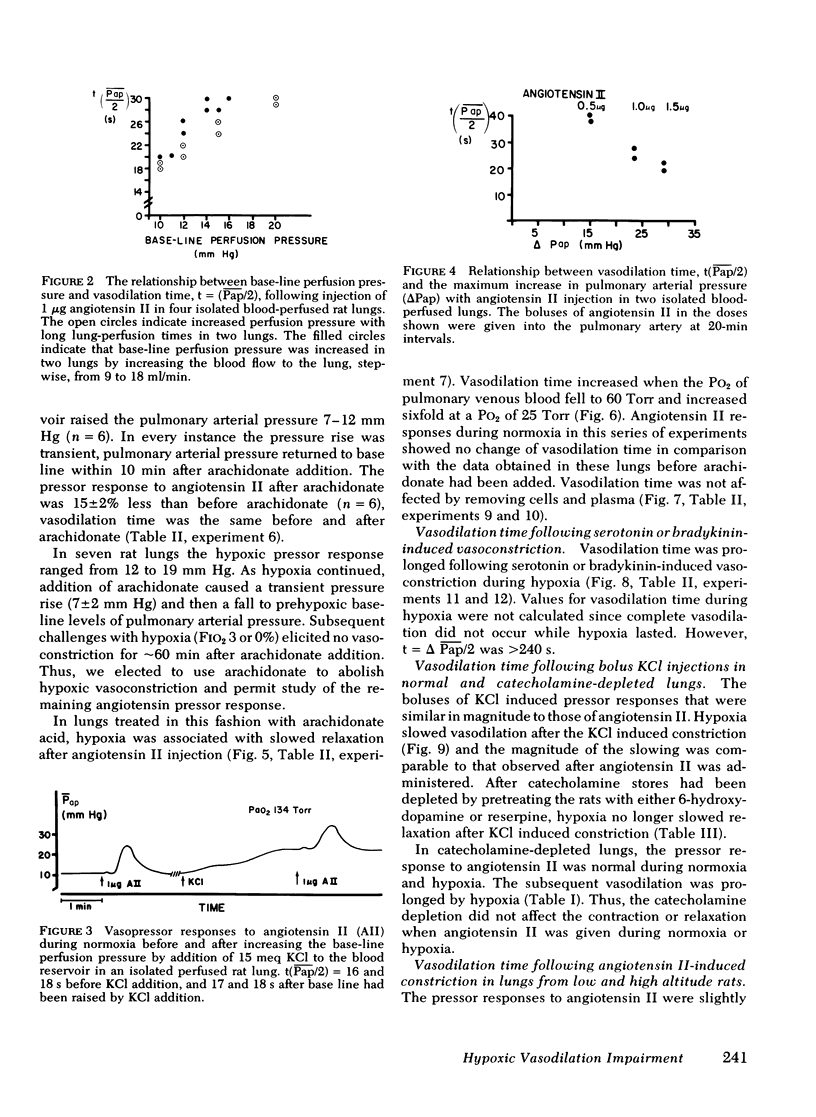
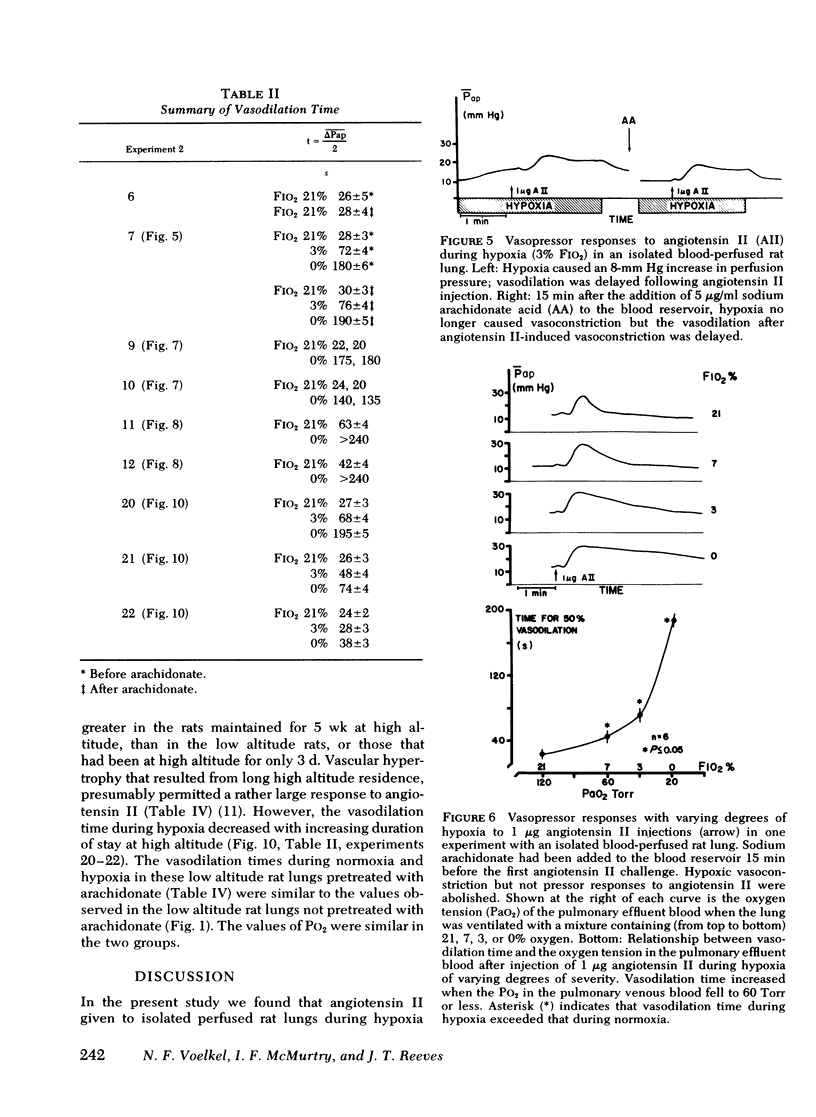
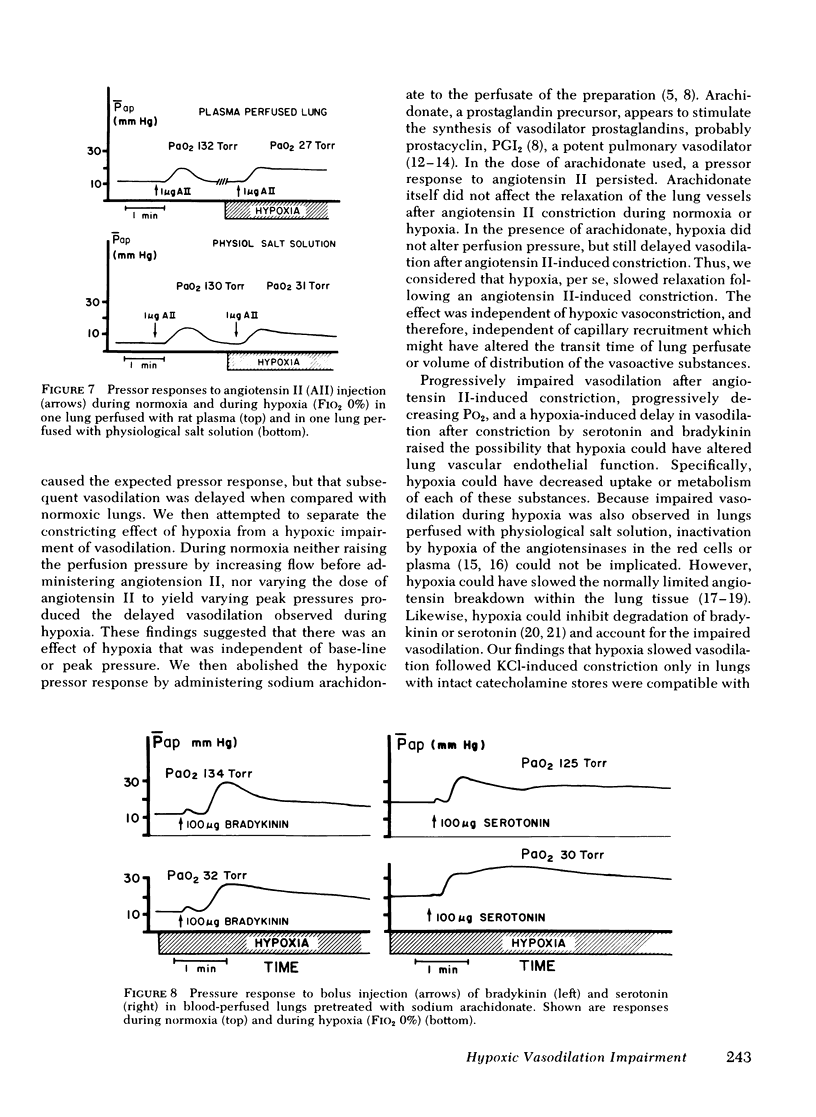
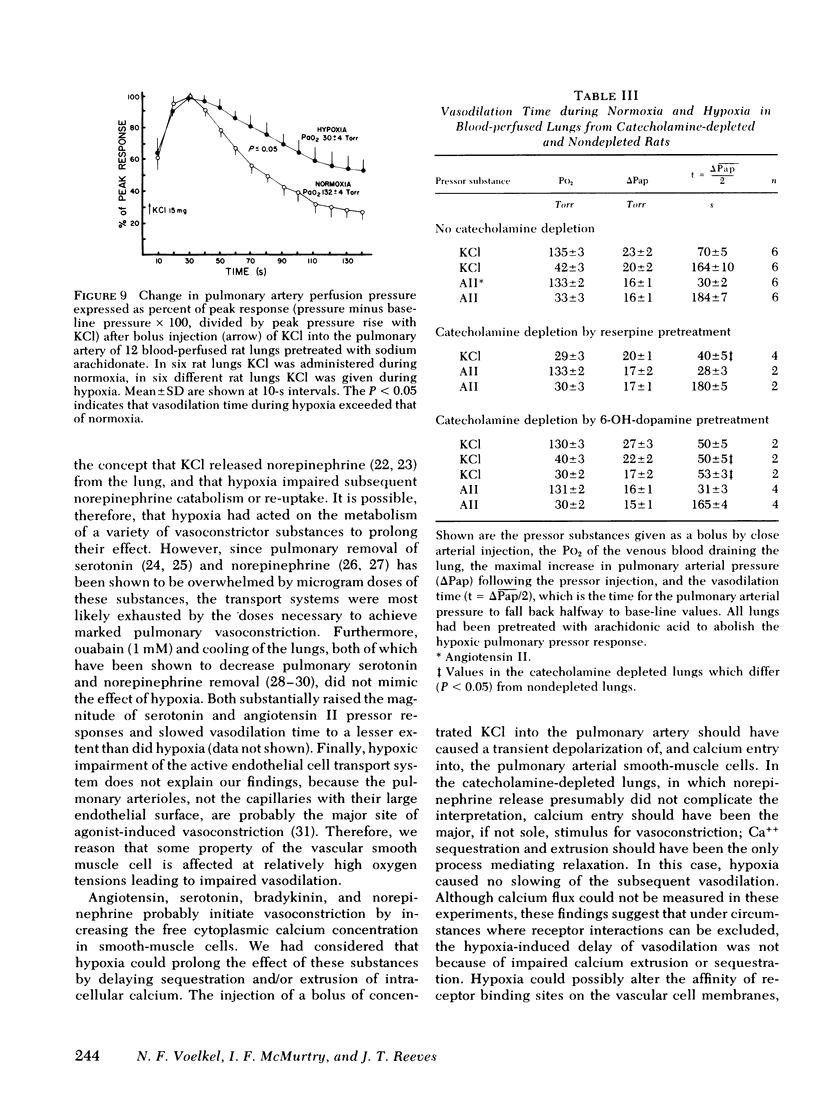
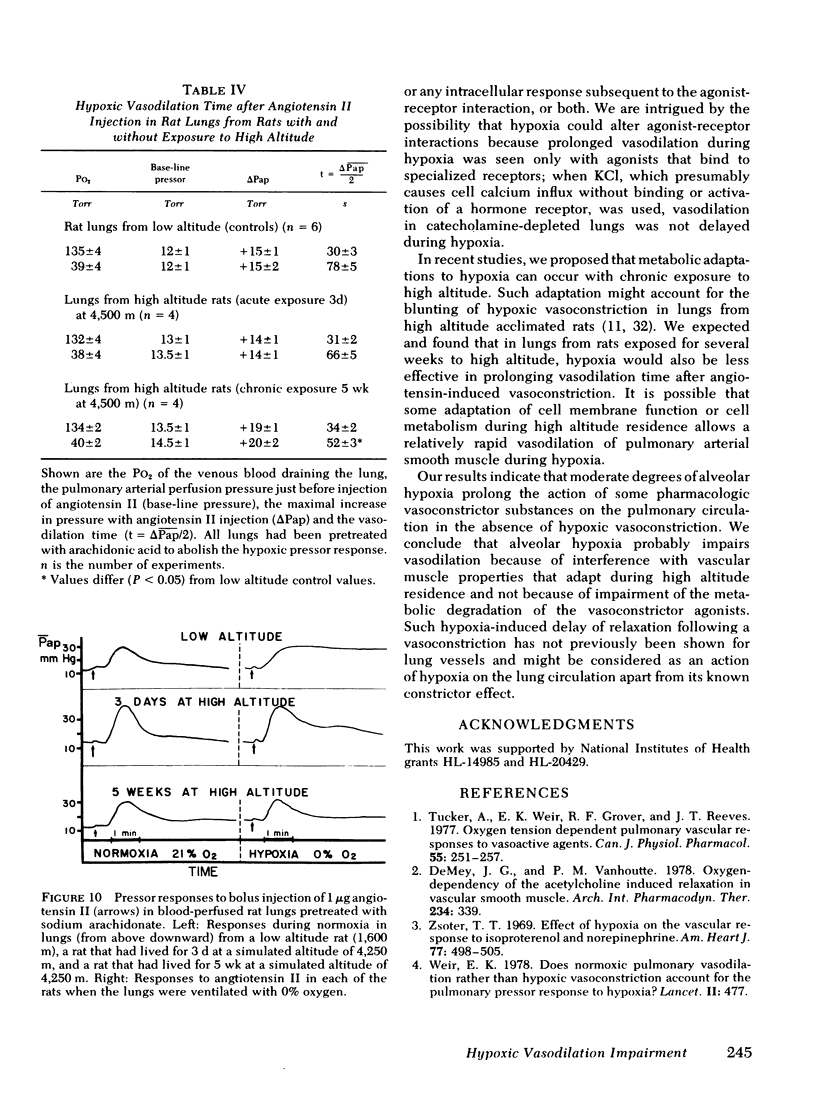
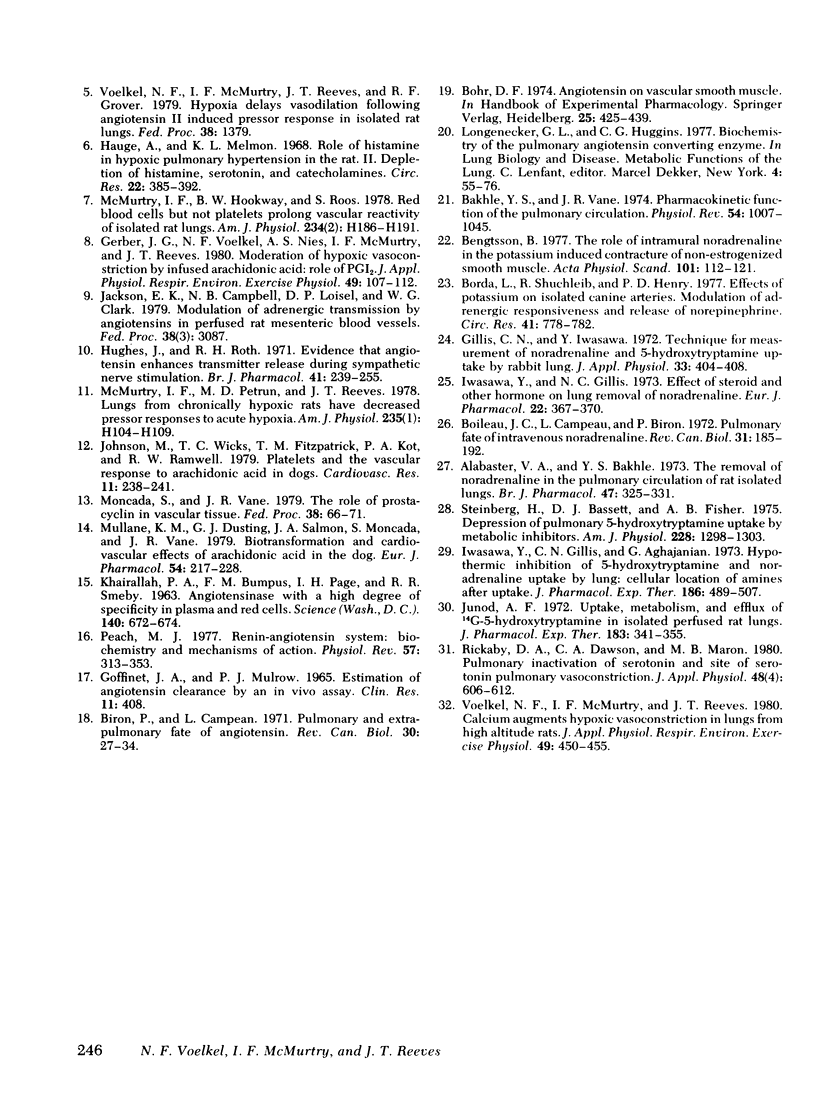
Selected References
These references are in PubMed. This may not be the complete list of references from this article.
- Alabaster V. A., Bakhle Y. S. The removal of noradrenaline in the pulmonary circulation of rat isolated lungs. Br J Pharmacol. 1973 Feb;47(2):325–331. doi: 10.1111/j.1476-5381.1973.tb08330.x. [DOI] [PMC free article] [PubMed] [Google Scholar]
- Bakhle Y. S., Vane J. R. Pharmacokinetic function of the pulmonary circulation. Physiol Rev. 1974 Oct;54(4):1007–1045. doi: 10.1152/physrev.1974.54.4.1007. [DOI] [PubMed] [Google Scholar]
- Bengtsson B. The role of intramural noradrenaline in the potassium induced contracture of non-estrogenized smooth muscle. Acta Physiol Scand. 1977 Sep;101(1):112–121. doi: 10.1111/j.1748-1716.1977.tb05989.x. [DOI] [PubMed] [Google Scholar]
- Biron P., Campeau L. Pulmonary and extrapulmonary fate of angiotensin I. Rev Can Biol. 1971 Mar;30(1):27–34. [PubMed] [Google Scholar]
- Boileau J. C., Campeau L., Biron P. Pulmonary fate of intravenous norepinephrine. Rev Can Biol. 1972 Sep;31(3):185–192. [PubMed] [Google Scholar]
- Borda L., Shuchleib R., Henry P. D. Effects of potassium on isolated canine coronary arteries. Modulation of adrenergic responsiveness and release of norepinephrine. Circ Res. 1977 Dec;41(6):778–786. doi: 10.1161/01.res.41.6.778. [DOI] [PubMed] [Google Scholar]
- Gerber J. G., Voelkel N., Nies A. S., McMurtry I. F., Reeves J. T. Moderation of hypoxic vasoconstriction by infused arachidonic acid: role of PGI2. J Appl Physiol Respir Environ Exerc Physiol. 1980 Jul;49(1):107–112. doi: 10.1152/jappl.1980.49.1.107. [DOI] [PubMed] [Google Scholar]
- Gillis C. N., Iwasawa Y. Technique for measurement of norepinephrine and 5-hydroxytryptamine uptake by rabbit lung. J Appl Physiol. 1972 Sep;33(3):404–408. doi: 10.1152/jappl.1972.33.3.404. [DOI] [PubMed] [Google Scholar]
- Hauge A., Melmon K. L. Role of histamine in hypoxic pulmonary hypertension in the rat. II. Depletion of histamine, serotonin, and catecholamines. Circ Res. 1968 Mar;22(3):385–392. doi: 10.1161/01.res.22.3.385. [DOI] [PubMed] [Google Scholar]
- Hughes J., Roth R. H. Evidence that angiotensin enhances transmitter release during sympathetic nerve stimulation. Br J Pharmacol. 1971 Feb;41(2):239–255. doi: 10.1111/j.1476-5381.1971.tb08025.x. [DOI] [PMC free article] [PubMed] [Google Scholar]
- Iwasawa Y., Gillis C. N., Aghajanian G. Hypothermic inhibition of 5-hydroxytryptamine and norepinephrine uptake by lung: cellular location of amines after uptake. J Pharmacol Exp Ther. 1973 Sep;186(3):498–507. [PubMed] [Google Scholar]
- Iwasawa Y., Gillis C. N. Effect of steroid and other hormones on lung removal of noradrenaline. Eur J Pharmacol. 1973 Jun;22(3):367–370. doi: 10.1016/0014-2999(73)90041-1. [DOI] [PubMed] [Google Scholar]
- Johnson M., Wicks T. C., Fitzpatrick T. M., Kot P. A., Ramwell P. W., Rose J. C. Platelets and the vascular responses to arachidonic acid in dogs. Cardiovasc Res. 1977 May;11(3):238–241. doi: 10.1093/cvr/11.3.238. [DOI] [PubMed] [Google Scholar]
- Junod A. F. Uptake, metabolism and efflux of 14 C-5-hydroxytryptamine in isolated perfused rat lungs. J Pharmacol Exp Ther. 1972 Nov;183(2):341–355. [PubMed] [Google Scholar]
- KHAIRALLAH P. A., BUMPUS F. M., PAGE I. H., SMEBY R. R. Angiotensinase with a high degree of specificity in plasma and red cells. Science. 1963 May 10;140(3567):672–674. doi: 10.1126/science.140.3567.672. [DOI] [PubMed] [Google Scholar]
- McMurtry I. F., Hookway B. W., Roos S. D. Red blood cells but not platelets prolong vascular reactivity of isolated rat lungs. Am J Physiol. 1978 Feb;234(2):H186–H191. doi: 10.1152/ajpheart.1978.234.2.H186. [DOI] [PubMed] [Google Scholar]
- McMurtry I. F., Petrun M. D., Reeves J. T. Lungs from chronically hypoxic rats have decreased pressor response to acute hypoxia. Am J Physiol. 1978 Jul;235(1):H104–H109. doi: 10.1152/ajpheart.1978.235.1.H104. [DOI] [PubMed] [Google Scholar]
- Moncada S., Vane J. R. The role of prostacyclin in vascular tissue. Fed Proc. 1979 Jan;38(1):66–71. [PubMed] [Google Scholar]
- Mullane K. M., Dusting G. J., Salmon J. A., Moncada S., Vane J. R. Biotransformation and cardiovascular effects of arachidonic acid in the dog. Eur J Pharmacol. 1979 Mar 1;54(3):217–228. doi: 10.1016/0014-2999(79)90080-3. [DOI] [PubMed] [Google Scholar]
- Peach M. J. Renin-angiotensin system: biochemistry and mechanisms of action. Physiol Rev. 1977 Apr;57(2):313–370. doi: 10.1152/physrev.1977.57.2.313. [DOI] [PubMed] [Google Scholar]
- Rickaby D. A., Dawson C. A., Maron M. B. Pulmonary inactivation of serotonin and site of serotonin pulmonary vasoconstriction. J Appl Physiol Respir Environ Exerc Physiol. 1980 Apr;48(4):606–612. doi: 10.1152/jappl.1980.48.4.606. [DOI] [PubMed] [Google Scholar]
- Steinberg H., Bassett D. J., Fisher A. B. Depression of pulmonary 5-hydroxytryptamine uptake by metabolic inhibitors. Am J Physiol. 1975 May;228(5):1298–1303. doi: 10.1152/ajplegacy.1975.228.5.1298. [DOI] [PubMed] [Google Scholar]
- Tucker A., Weir E. K., Grover R. F., Reeves J. T. Oxygen-tension-dependent pulmonary vascular responses to vasoactive agents. Can J Physiol Pharmacol. 1977 Apr;55(2):251–257. doi: 10.1139/y77-036. [DOI] [PubMed] [Google Scholar]
- Voelkel N. F., Morris K. G., McMurtry I. F., Reeves J. T. Calcium augments hypoxic vasoconstriction in lungs from high-altitude rats. J Appl Physiol Respir Environ Exerc Physiol. 1980 Sep;49(3):450–455. doi: 10.1152/jappl.1980.49.3.450. [DOI] [PubMed] [Google Scholar]
- Weir E. K. Does normoxic pulmonary vasodilatation rather than hypoxic vasoconstriction account for the pulmonary pressor response to hypoxia? Lancet. 1978 Mar 4;1(8062):476–477. doi: 10.1016/s0140-6736(78)90138-1. [DOI] [PubMed] [Google Scholar]
- Zsotér T. T. Effect of hypoxia on the vascular response to isoproterenol and norepinephrine. Am Heart J. 1969 Apr;77(4):498–505. doi: 10.1016/0002-8703(69)90159-8. [DOI] [PubMed] [Google Scholar]
- de Mey J. G., Vanhoutte P. M. Oxygen-dependency of the acetylcholine induced relaxation in vascular smooth muscle. Arch Int Pharmacodyn Ther. 1978 Aug;234(2):339–339. [PubMed] [Google Scholar]


